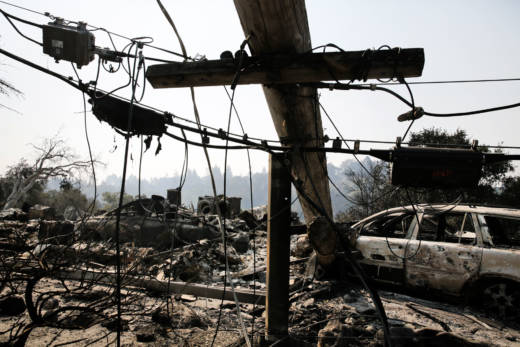The finding adds to the growing financial liability of PG&E over wildfires in the state.
The company’s equipment has now been blamed for starting 13 wildfires last year, including two that killed a total of 15 people. In eight blazes, investigators said they found evidence of violations of state law and forwarded the findings to county prosecutors.
PG&E last week agreed to pay $1.5 million to Butte County to avoid misdemeanor criminal charges after Cal Fire determined downed power lines caused three wildfires in the region.
The utility has told shareholders it expects to pay more than $2.5 billion in damages.
Cal Fire investigators found no negligence on the part of PG&E. Nonetheless, California law compels utilities to pay for damages from wildfires if their equipment caused the blazes — even if the utilities weren’t negligent.
PG&E spent millions of dollars in an 11th hour lobbying effort at the end of the California legislative session in a failed attempt to change the law to reduce its financial liability.
State officials say insured damages alone topped $9 billion and PG&E could be liable for much of it. Insurance companies have filed dozens of lawsuits calling for PG&E to reimburse them for settling claims from policyholders.
Last month, Gov. Jerry Brown signed a measure allowing utilities to bill their customers to pay for future legal settlements stemming from devastating 2017 wildfires, even if the blazes are blamed on the company’s mismanagement.
PG&E spokeswoman Lynsey Paulo said Tuesday that “extreme weather, years of drought, and millions of dead trees are feeding an unprecedented risk of wildfires.”
Paulo said, “we recognize we all need to do even more to help reduce the risk of wildfires and are committed to working together with our state and community partners to develop comprehensive safety solutions.”
Paulo said the utility is working on improving fire prevention by strengthening poles and lines, upgrading weather modeling and clearing vegetation around equipment.
Authorities have still not determined fault for the Tubbs Fire, the most destructive blaze in state history. That fire destroyed thousands of homes and killed 22 people in Sonoma County.
PG&E is facing dozens of lawsuits from insurers that have spent billions settling insurance claims from homeowners.
This post has been updated.

